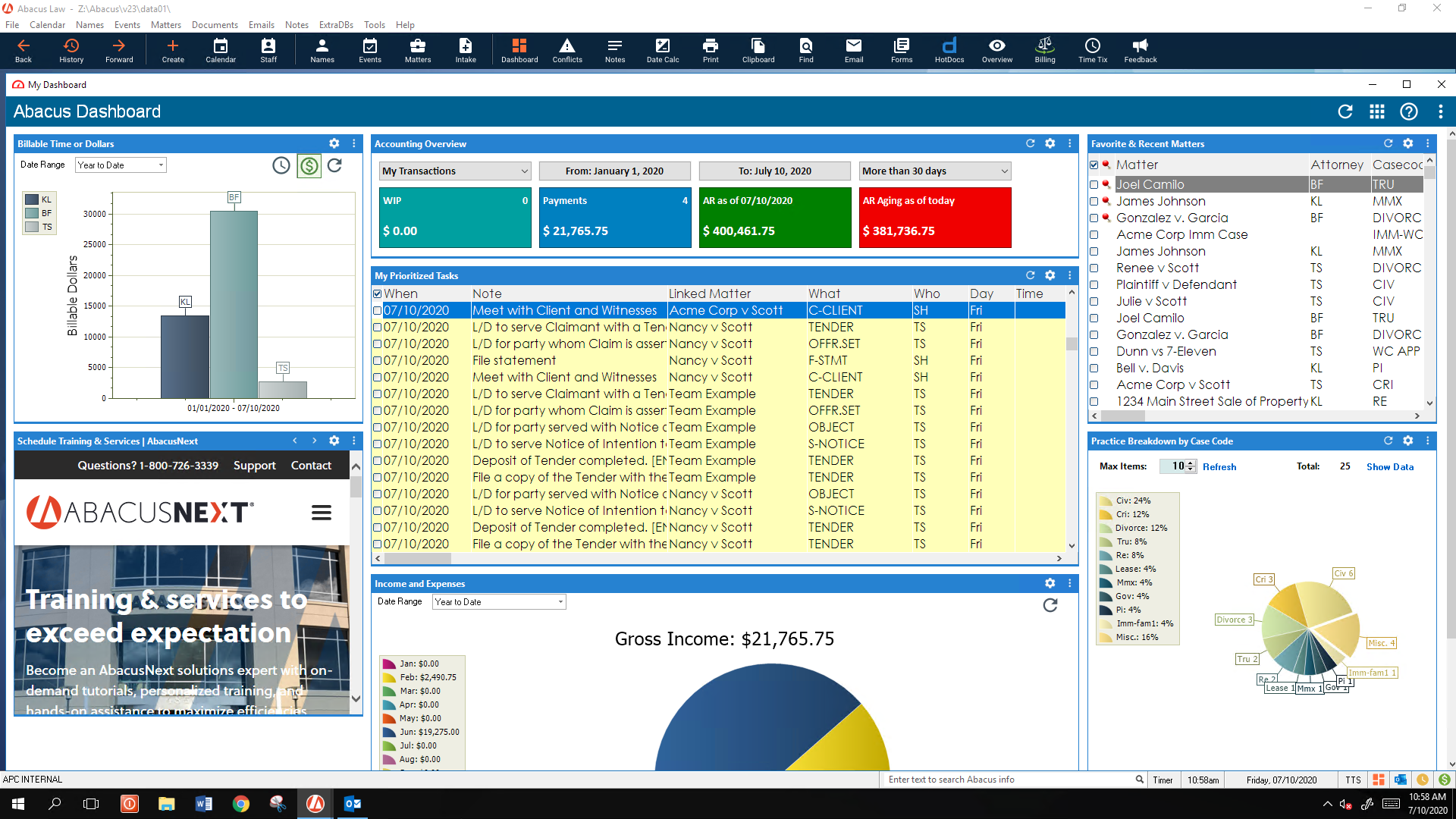KPIs for Your Law Firm

Running and managing a successful law firm is about more than just the practice of law. While many lawyers understandably focus most, if not all, of their attention on providing the best possible legal services for their clients, it’s important to stop and make sure those efforts are actually leading to success for your firm.
As the saying goes, what gets measured gets managed. Law firm KPIs are one of the most useful ways small firms can monitor success and assess whether firm goals are being met.
What Are Law Firm Performance Metrics and How Do They Benefit You?
Law firm KPIs, or key performance indicators, are metrics used to evaluate specific goals and aspects of your firm’s success. By tracking KPIs, you obtain valuable data that provides insight into how your firm is functioning and whether your performance is meeting your expectations across specific areas.
Every KPI you set and track should meet three basic criteria:
- It should reflect your firm’s strategy and goals.
- It must be critical to your firm’s overall success.
- It needs to be quantifiable so it can be monitored and tracked.
When you tailor your KPIs to the unique goals you have for your firm, you’re able to answer critical questions about how your firm is performing and make informed decisions that ultimately improve major drivers like firm revenue and growth. Tracking law firm performance metrics also allows you to adjust and adapt as the legal landscape continues to shift.
What Law Firm KPIs Should You Track?
There are potentially hundreds of law firm performance metrics you could track to measure success, but no firm should try to tackle that many out of the gate. Instead, start by tracking a few, and once you’re comfortable with your tracking strategy, you can add more.
Nearly every aspect of law firm operations can be monitored today, but the best approach is to start with metrics that are most central to your success. A few good areas to focus on at the start are client acquisition rates and satisfaction, firm productivity and utilization, and firm cash flows. Making sure you’re at least meeting minimum goals in these areas will go a long way toward positioning your firm for success. If you find out that you’re underperforming anywhere, you can quickly address the problem and put yourself on the right path going forward.
The following frequently tracked law firm metrics are a good starting point for KPI tracking:
1. Client satisfaction:
it’s relatively simple to gather client feedback using a web survey or telephone interview. Set up a survey site, and include the link to your email signature, or send an invitation to each client when an active matter closes.
2. Client development:
Client development is essentially business development: the methods by which a firm attracts prospective clients and manages ongoing relationships with existing clients. Track your win rate – of 100 initial contacts, how many become clients? For ongoing clients, set and track specific targets for new work from existing clients.
3. Cost of client acquisition (CAC):
Simply put, expenses related to acquiring new clients – marketing, advertising, sponsorships, events, and the cost of your time in billable hours – are the cost of acquisition. Divide one month’s acquisition cost by the number of new clients won in the month, to determine the CAC per client. Your target for the cost of client acquisition depends on the type of law and the return on investment per client; some become long-term retainer relationships, and others are clients for a single case only.
4. Attorney realization rates:
Are attorneys maximizing revenue from billable work? Realization is a measure of how much time an attorney records in comparison with the fees that are collected. Realization is expressed as a percentage; fees are recorded divided by fees collected.
5. Law firm profitability:
To remain profitable, revenues must of course exceed costs. To calculate your firm’s net profit margin, determine your total revenues for a financial period (typically a calendar quarter or year). From that, subtract all operating expenses, including payroll, office expenses, software, and IT services, marketing, and travel expenses.
Once you’ve mastered your initial tracking group, you can start tracking more KPIs in a number of other important areas, including profitability, marketing, client development, individual employee performance, and firm culture.
Tracking KPIs helps measure the ROI of your technology. Check out our free whitepaper The ROI of the Cloud for more ways to see the bottom-line impact of your legal tech.
How to Implement Law Firm KPI Tracking
Once you decide to start tracking KPIs, the next step is to implement a strategy for doing so. You should be clear on which KPIs you plan to monitor, how and when you plan to monitor them, and what you’re going to do with the data that’s generated.
You need to know exactly what your KPIs are and what they mean, what the targets are that you want to be hitting and how variances from those targets will be assessed and addressed. You should be setting a regular schedule for evaluating your KPIs, ideally on a monthly basis.
Legal practice management software makes KPI tracking easy
Your legal practice management software can help with KPI tracking and do the heavy lifting for you, so you can continue to focus on what you do best – practicing law. It’s important to remember that your KPIs might change over time. What is most crucial for you to track today might not be the case down the road as your firm grows and the world continues to change.
The benefit of a KPI dashboard
Using the right tools to track KPIs will help you be more agile and able to shift your tracking strategy to meet changing demands. When evaluating a practice management system, look for tools or reports that can handle the performance metrics that matter to you. A visual dashboard is a great way to track metrics, displaying real-time progress toward your goals.
 For example, the Abacus law firm KPI dashboard puts you in the driver’s seat in managing goals and metrics. The dashboard is customizable to fit the way you work, with the layout you like, and includes Google Search, Gmail, news, or other apps you want to follow. Choose your favorite clients and cases for one-click access to them. See current progress on your KPIs, with dashboard metrics that answer common operations questions, such as,
For example, the Abacus law firm KPI dashboard puts you in the driver’s seat in managing goals and metrics. The dashboard is customizable to fit the way you work, with the layout you like, and includes Google Search, Gmail, news, or other apps you want to follow. Choose your favorite clients and cases for one-click access to them. See current progress on your KPIs, with dashboard metrics that answer common operations questions, such as,
“Have I met my billable goals?” or “How much time do I spend on each type of case?”
What to include in your dashboard
A variety of dashboard metrics and graphs let you monitor your KPIs and track your progress toward your goals. Examples include:
- A list of active matters to keep current projects front and center
- A daily agenda with reminders, calls, and meetings
- A chart of matters, displaying the workloads across attorneys
- An accounting overview showing WIP, payments, AR, and AR aging, to alert you to areas that need attention
- Tracking income and expenses year-to-date or for any time period
- An “Any web page” feature to display a webpage from the district court, your bar association, or other resources
You know your firm better than anyone else. When you set KPIs around the things that make your firm uniquely great, you’ll be in the best possible position to know that you’re succeeding as a business and giving your clients the level of service they deserve.
If you’re already using AbacusLaw, Amicus Attorney, or Amicus Cloud, there are dashboard features you can take advantage of now.
If not, check out all the other benefits a legal practice management system can have on your firm’s productivity and efficiency.